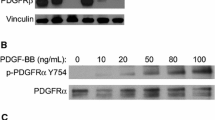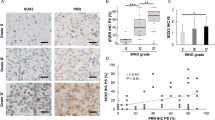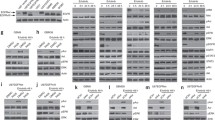Summary
Epidermal growth factor (EGF) has been shown to stimulate DNA synthesis and cell division in normal glia. At least half of malignant human gliomas (MHG) express high levels of the EGF receptor (EGFR), which are above those detected in normal brain. The demonstration that antibodies against the EGFR inhibit the growth of squamous cell carcinoma line A-431, with large numbers of EGFR, in vitro and in vivo raises the possibility that these agents could be used therapeutically against malignant human gliomas either alone or conjugated to other agents. We have measured the growth effects of EGF and an anti-EGFR monoclonal antibody, 528 (Ab-528), on four well-characterized human malignant glioma cell lines, D-263 MG, D-247 MG, U-343 MGa Cl 2∶6, and D-37 MG, with 2.9×104, 1.5×105, 8.6×105 and 1.59×106 EGFRs per cell, respectively. EGF significantly increased cell number in D-263 MG and D-37 MG by 65% and 74%, respectively, had no effect on D-247 MG, and significantly decreased cell number in U-343 MGa Cl 2∶6 by 39%. U-343 MGa Cl 2∶6 growth was inhibited 19% by Ab-528, but Ab-528 had no effect on growth of the other MHG lines. Ab-528 significantly inhibited all EGF-mediated growth effects. These studies demonstrate that, although Ab-528 alone has little antiproliferative activity on MGH, it successfully competes with EGF to reduce the biological effects of EGF-EGFR binding. Therefore, this antibody could potentially be used to target radioisotopes to MHG via the EGFR for diagnosis and therapy.
Similar content being viewed by others
References
Banks-Schlegel SP, Quintero J (1986) Human esophageal carcinoma cells have fewer, but higher affinity epidermal growth factor receptors. J Biol Chem 261: 4359–4362
Bigner DD, Bigner SH, Pontén J, Westermark B, Mahaley MS Jr, Ruoslahti E, Herschman H, Eng LF, Wikstrand CJ (1981) Heterogeneity of genotypic and phenotypic characteristics of fifteen permanent cell lines derived from human gliomas. J Neuropathol Exp Neurol 40: 201–229
Bigner SH, Bullard DE, Pegram CN, Wikstrand CJ, Bigner DD (1981) Relationship of in vitro morphologic and growth characteristics of established human glioma-derived cell lines to their tumorigenicity in athymic nude mice. J Neuropathol Exp Neurol 40: 390–409
Bigner SH, Friedman HS, Biegel JA, Wikstrand CJ, Mark J, Gebhardt R, Eng LF, Bigner DD (1986) Specific chromosomal abnormalities characterize four established cell lines derived from malignant human gliomas. Acta Neuropathol (Berl) 72: 86–97
Bigner SH, Burger PC, Wong AJ, Werner MH, Hamilton SR, Muhlbaier LH, Vogelstein B, Bigner DD (1988) Gene amplification in malignant human gliomas: clinical and histopathologic aspects. J Neuropathol Exp Neurol 47: 191–205
Buss JE, Kudlow JE, Lazar CS, Gill GN (1982) Altered epidermal growth factor (EGF)-stimulated protein kinase activity in variant A431 cells with altered growth responses to EGF. Proc Natl Acad Sci USA 79: 2574–2578
Carpenter G, Cohen S (1979) Epidermal growth factor. Annu Rev Biochem 48: 193–216
Cohen S, Carpenter G, King L Jr (1980) Epidermal growth factor-receptor-protein kinase interactions: co-purification of receptor and epidermal growth factor-enhanced phosphorylation activity. J Biol Chem 255: 4834–4842
Damjanov I, Mildner B, Knowles B (1986) Immunohistochemical localization of the epidermal growth factor receptor in normal human tissues. Lab Invest 55: 588–592
Filmus J, Pollak MN, Cailleau R, Buick RN (1985) MDA-468, a human breast cancer cell line with a high number of epidermal growth factor (EGF) receptors, has an amplified EGF receptor gene and is growth inhibited by EGF. Biochem Biophys Res Commun 128: 898–905
Filmus J, Pollak MN, Cairncross JG, Buick RN (1985) Amplified, overexpressed and rearranged epidermal growth factor receptor gene in a human astrocytoma cell line. Biochem Biophys Res Commun 131: 207–215
Gamou S, Kim YS, Shimizu N (1984) Different responses to EGF in two human carcinoma cell lines, A431 and UCVA-1, possessing high numbers of EGF receptors. Mol Cell Endocrinol 37: 205–213
Humphrey PA, Wong AJ, Vogelstein B, Friedman HS, Werner MH, Bigner DD, Bigner SH (1988) Amplification and expression of the epidermal growth factor receptor gene in human glioma xenografts. Cancer Res 48: 2231–2238
Hutchings S, Sato GH (1978) Growth maintenance of HeLa cells in serum-free medium supplemented with hormones. Proc Natl Acad Sci USA 75: 901–904
Imai Y, Leung CKH, Friesen HG, Shiu RPC (1982) Epidermal growth factor receptors and effect of epidermal growth factor on growth of human breast cancer cells in long-term tisue culture. Cancer Res 42: 4394–4398
Kamata N, Chida K, Rikimaru K, Horikoshi M, Enomoto S, Kuroki T (1986) Growth-inhibitory effects of epidermal growth factor and overexpression of its receptors on human squamous cell carcinomas in culture. Cancer Res 46: 1648–1653
Kawamoto T, Sato JD, Le A, Polikoff J, Sato GH, Mendelsohn J (1983) Growth stimulation of A431 cells by epidermal growth factor: identification of high-affinity receptors for epidermal growth factor by an anti-receptor monoclonal antibody. Proc Natl Acad Sci USA 80: 1337–1341
Kawamoto T, Mendelsohn J, Le A, Sato GH, Lazar CS, Gill GN (1984) Relation of epidermal growth factor receptor concentration to growth of human epidermoid carcinoma A431 cells. J Biol Chem 259: 7761–7766
Korc M, Padilla J, Grosso D (1986) Epidermal growth factor inhibits the proliferation of a human endometrial carcinoma cell line. J Clin Endocrinol Metab 62: 874–880
Korc M, Haussler CA, Trookman NS (1987) Divergent effects of epidermal growth factor and transforming growth factors on a human endometrial carcinoma cell line. Cancer Res 47: 4909–4914
Kurtzberg J, Hershfield MS (1984) Determinants of deoxyadenosine toxicity in hybrids between human T and B lymphoblasts as a model for the development of drug resistance in T cell acute lymphoblastic leukemia. Cancer Res 45: 1579–1586
Leutz A, Schachner M (1981) Epidermal growth factor (EGF) stimulates DNA synthesis of astrocytes in primary cerebellar cultures. Cell Tissue Res 220: 393–404
Libermann TA, Razon N, Bartal AD, Yarden Y, Schlessinger J, Soreq H (1984) Expression of epidermal growth factor receptors in human brain tumors. Cancer Res 44: 753–760
Libermann TA, Nusbaum HR, Razon N, Kris R, Lax I, Soreq H, Whittle N, Waterfield MD, Ullrich A, Schlessinger J (1985) Amplification, enhanced expression and possible rearrangement of EGF receptor gene in primary human brain tumours of glial origin. Nature 313: 144–147
Lowry OH, Rosebrough NJ, Farr AL, Randall RJ (1951) Protein measurement with the folin phenol reagent. J Biol Chem 193: 265–277
Masui H, Kawamoto T, Sato JD, Wolf B, Sato G, Mendelsohn J (1984) Growth inhibition of human tumor cells in athymic mice by anti-epidermal growth factor receptor monoclonal antibodies. Cancer Res 44: 1002–1007
McPherson GA (1983) A practical computer based approach to the analysis of radioligand experiments. Computer Programs Biomed 17: 107–114
Morrison RS, Kornblum HI, Leslie FM, Bradshaw RA (1987) Trophic stimulation of cultured neurons from neonatal rat brain by epidermal growth factor. Science 238: 72–75
Munson PJ, Robard D (1980) A versatile computerized approach for the characterization of ligand binding systems. Anal Biochem 107: 220–239
Nanney LB, Magid M, Stoscheck CM, King LE (1984) Epidermal growth factor binding and receptor distribution in normal human skin and appendages. J Invest Dermatol 83: 385–393
Nister M, Wedell B, Betsholtz C, Bywater M, Pettersson M, Westermark B, Mark J (1987) Evidence for progressional changes in the human malignant glioma line U-343 MGa: analysis of karyotype and expression of genes encoding the subunit chains of platelet-derived growth factor. Cancer Res 47: 4953–4960
Richter A (1970) Improved medium for the cultivation of differentiated liver cells. In Vitro 6: 220–221
Rodeck V, Herlyn M, Herlyn D, Molthoff C, Atkinson B, Varello M, Steplewski A, Koprowski H (1987) Tumor growth modulation by a monoclonal antibody to the epidermal growth factor receptor: immunologically mediated and effector cell-independent effects. Cancer Res 47: 3692–3696
Samuels V, Pantazio CG, Allen MB, Wright S, Yaghmai F, Lobel S (1987) Immunohistochemical detection of transforming growth factor alpha in tumors of glial origin. Proc Am Assoc Cancer Res 28: 55
Sato JD, Kawamoto T, Le AD, Mendelsohn J, Polikoff J, Sato GH (1983) Biological effects in vitro of monoclonal antibodies to human epidermal growth factor receptors. Mol Biol Med 1: 511–529
Simpson DL, Morrison R, de Vellis J, Herschman HR (1982) Epidermal growth factor binding and mitogenic activity on purified populations of cells from the central nervous system. J Neurosci Res 8: 453–462
Singletary SE, Baker FL, Spitzer G, Tucker SL, Tomasovic B, Brock WA, Ajani JA, Kelly AM (1987) Biological effect of epidermal growth factor on the in vitro growth of human tumors. Cancer Res 47: 403–406
Stoscheck CM King LE Jr (1986) Role of epidermal growth factor in carcinogenesis. Cancer Res 46: 1030–1037
Stromberg K, Hudging WR, Dorman LS, Henderson LE, Sowder RC, Sherrell BJ, Mount CD, Orth DN (1987) Human brain tumor-associated urinary high molecular weight transforming growth factor: a high molecular weight form of epidermal growth factor. Cancer Res 47: 1190–1196
Takahashi H, Herlyn D, Atkinson B, Powe J, Rodeck V, Alavi A, Bruce DA, Koprowski H (1987) Radioimmunodetection of human glioma xenografts by monoclonal antibody to epidermal growth factor receptor. Cancer Res 47: 3847–3850
Ushiro H, Cohen S (1980) Identification of phosphotyrosine as a product of epidermal growth factor-activated protein kinase in A-431 cell membranes. J Biol Chem 255: 8363–8365
Werner MH, Nanney LB, Stoscheck CM, King LE (1988) Localization of immunoreactive epidermal growth factor receptors in human nervous system. J Histochem Cytochem 36: 81–86
Westermark B (1976) Density dependent proliferation of human glia cells stimulated by epidermal growth factor. Biochem Biophys Res Commun 69: 304–309
Westermark B, Magnusson A, Heldin C-H (1982) Effect of epidermal growth factor on membrane motility and cell locomotion in cultures of human clonal glioma cells. J Neurosci Res 8: 491–507
Wong AJ, Bigner SH, Bigner DD, Kinzler KW, Hamilton SR, Vogelstein B (1987) Increased expression of the epidermal growth factor receptor gene in malignant gliomas is invariably associated with gene amplification. Proc Natl Acad Sci USA 84: 6899–6903
Author information
Authors and Affiliations
Additional information
Supported by Grants CA-11898, NS-20023, CA-43722, and the Association for Brain Tumor Research (MHW, PAH)
Rights and permissions
About this article
Cite this article
Werner, M.H., Humphrey, P.A., Bigner, D.D. et al. Growth effects of epidermal growth factor (EGF) and a monoclonal antibody against the EGF receptor on four glioma cell lines. Acta Neuropathol 77, 196–201 (1988). https://doi.org/10.1007/BF00687431
Received:
Accepted:
Issue Date:
DOI: https://doi.org/10.1007/BF00687431




